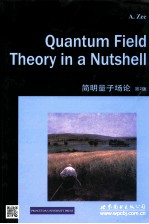

简明量子场论 第2版 英文PDF电子书下载
- 电子书积分:17 积分如何计算积分?
- 作 者:(美)徐一鸿著
- 出 版 社:北京/西安:世界图书出版公司
- 出版年份:2013
- ISBN:7510061448
- 页数:576 页
Part Ⅰ:Motivation and Foundation 3
Ⅰ.1 Who Needs It? 3
Ⅰ.2 Path Integral Formulation of Quantum Physics 7
Ⅰ.3 From Mattress to Field 17
Ⅰ.4 From Field to Particle to Force 26
Ⅰ.5 Coulomb and Newton:Repulsion and Attraction 32
Ⅰ.6 Inverse Square Law and the Floating 3-Brane 40
Ⅰ.7 Feynman Diagrams 43
Ⅰ.8 Quantizing Canonically 61
Ⅰ.9 Disturbing the Vacuum 70
Ⅰ.10 Symmetry 76
Ⅰ.11 Field Theory in Curved Spacetime 81
Ⅰ.12 Field Theory Redux 88
Part Ⅱ:Dirac and the Spinor 93
Ⅱ.1 The Dirac Equation 93
Ⅱ.2 Quantizing the Dirac Field 107
Ⅱ.3 Lorentz Group and Weyl Spinors 114
Ⅱ.4 Spin-Statistics Connection 120
Ⅱ.5 Vacuum Energy,Grassmann Integrals,and Feynman Diagrams for Fermions 123
Ⅱ.6 Electron Scattering and Gauge Invariance 132
Ⅱ.7 Diagrammatic Proof of Gauge Invariance 144
Ⅱ.8 Photon-Electron Scattering and Crossing 152
Part Ⅲ:Renormalization and Gauge Invariance 161
Ⅲ.1 Cutting Off Our Ignorance 161
Ⅲ.2 Renormalizable versus Nonrenormalizable 169
Ⅲ.3 Counterterms and Physical Perturbation Theory 173
Ⅲ.4 Gauge Invariance:A Photon Can Find No Rest 182
Ⅲ.5 Field Theory without Relativity 190
Ⅲ.6 The Magnetic Moment of the Electron 194
Ⅲ.7 Polarizing the Vacuum and Renormalizing the Charge 200
Ⅲ.8 Becoming Imaginary and Conserving Probability 207
Part Ⅳ:Symmetry and Symmetry Breaking 223
Ⅳ.1 Symmetry Breaking 223
Ⅳ.2 The Pion as a Nambu-Goldstone Boson 231
Ⅳ.3 Effective Potential 237
Ⅳ.4 Magnetic Monopole 245
Ⅳ.5 Nonabelian Gauge Theory 253
Ⅳ.6 The Anderson-Higgs Mechanism 263
Ⅳ.7 Chiral Anomaly 270
Part Ⅴ:Field Theory and Collective Phenomena 283
Ⅴ.1 Superfluids 283
Ⅴ.2 Euclid,Boltzmann,Hawking,and Field Theory at Finite Temperature 287
Ⅴ.3 Landau-Ginzburg Theory of Critical Phenomena 292
Ⅴ.4 Superconductivity 295
Ⅴ.5 Peierls Instability 298
Ⅴ.6 Solitons 302
Ⅴ.7 Vortices,Monopoles,and Instantons 306
Part Ⅵ: Field Theory and Condensed Matter 315
Ⅵ.1 Fractional Statistics,Chern-Simons Term,and Topological Field Theory 315
Ⅵ.2 Quantum Hall Fluids 322
Ⅵ.3 Duality 331
Ⅵ.4 The σ Models as Effective Field Theories 340
Ⅵ.5 Ferromagnets and Antiferromagnets 344
Ⅵ.6 Surface Growth and Field Theory 347
Ⅵ.7 Disorder:Replicas and Grassmannian Symmetry 350
Ⅵ.8 Renormalization Group Flow as a Natural Concept in High Energy and Condensed Matter Physics 356
Part Ⅶ:Grand Unification 371
Ⅶ.1 Quantizing Yang-Mills Theory and Lattice Gauge Theory 371
Ⅶ.2 Electroweak Unification 379
Ⅶ.3 Quantum Chromodynamics 385
Ⅶ.4 Large N Expansion 394
Ⅶ.5 Grand Unification 407
Ⅶ.6 Protons Are Not Forever 413
Ⅶ.7 SO(10)Unifcation 421
Part Ⅷ:Gravity and Beyond 433
Ⅷ.1 Gravity as a Field Theory and the Kaluza-Klein Picture 433
Ⅷ.2 The Cosmological Constant Problem and the Cosmic Coincidence Problems 448
Ⅷ.3 Effective Field Theory Approach to Understanding Nature 452
Ⅷ.4 Supersymmetry:A Very Brief Introduction 461
Ⅷ.5 A Glimpse of String Theory as a 2-Dimensional Field Theory 469
Closing Words 473
Part N 479
N.1 Gravitational Waves and Effective Field Theory 479
N.2 Gluon Scattering in Pure Yang-Mills Theory 483
N.3 Subterranean Connections in Gauge Theories 497
N.4 Is Einstein Gravity Secretly the Square of Yang-Mills Theory? 513
More Closing Words 521
Appendix A:Gaussian Integration and the Central Identity of Quantum Field Theory 523
Appendix B:A Brief Review of Group Theory 525
Appendix C:Feynman Rules 534
Appendix D:Various Identities and Feynman Integrals 538
Appendix E:Dotted and Undotted Indices and the Majorana Spinor 541
Solutions to Selected Exercises 545
Further Reading 559
Index 563
- 《量子系统的非平衡多体理论》(意)G.斯蒂芬尼茨,(德)R.冯·莱文 2019
- 《量子力学基础》郑伟谋著 2019
- 《量子规范场论的解释 理论、实验、数据分析》(中国)李继堂 2019
- 《高等量子力学》闫学群 2019
- 《量子计算数论=QUANTUM COMPUTATIONAL NUMBER THEORY》(英)颜松远著 2020
- 《实现你的愿景 创客量子能力7大法则》(美)克里斯蒂·惠特曼(CHRISTY WHITMAN)著 2020
- 《量子有限自动机 等价性和最小化》李绿周 2019
- 《量子力学=Quantum Mechanics(Jones & Bartlett):英文》(美)B.C.里德(Bruce Cameron Reed)著 2018
- 《鬼脸物理课 4 量子论与未来》刘继军著 2019
- 《佛法人生量子说》高月明著 2016
- 《TED说话的力量 世界优秀演讲者的口才秘诀》(坦桑)阿卡什·P.卡里亚著 2019
- 《小手画出大世界 恐龙世界》登亚编绘 2008
- 《近代世界史文献丛编 19》王强主编 2017
- 《课堂上听不到的历史传奇 世界政治军事名人 初中版》顾跃忠等编著 2015
- 《指向核心素养 北京十一学校名师教学设计 英语 七年级 上 配人教版》周志英总主编 2019
- 《365奇趣英语乐园 世界民间故事》爱思得图书国际企业 2018
- 《近代世界史文献丛编 36》王强主编 2017
- 《北京生态环境保护》《北京环境保护丛书》编委会编著 2018
- 《近代世界史文献丛编 11》王强主编 2017
- 《近代世界史文献丛编 18》王强主编 2017
